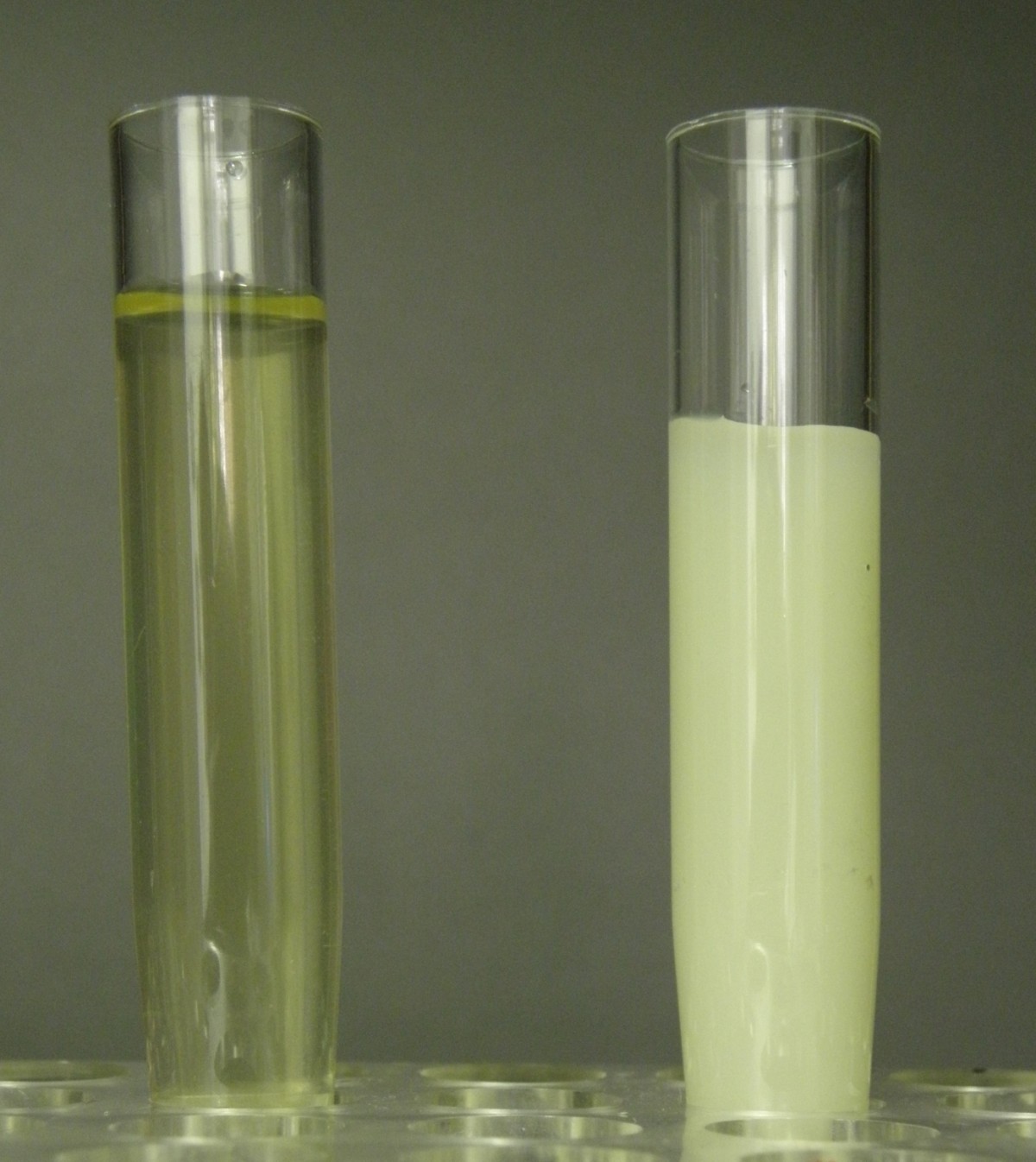Chyluria Definition
Chyluria or chylous urine is a condition with the presence of chyle in the urine, which results in milky urine. Chyle is a body fluid within the lymphatic vessels, which conveys the digested fat from the small intestine to the blood. Chyle consists of the lymph and lipid particles called chylomicrons, which are composed of fats and proteins [1].
Symptoms and Signs
Chyluria can be a debilitating condition that can have an intermittent (waxing and waning) and recurrent course [2]. The main symptom is thick, milky and possibly foamy urine [2]. Other symptoms and signs can include frequent and burning urination (dysuria), passing fat or blood clots, pinky or red urine due to the blood (hematuria), kidney pain, weakness, weight loss, fever and swelling of the legs or scrotum (hydrocele) [2,3]. Chyluria by itself is not life-threatening [4].
Picture 1. Urine appearance in chyluria.
Left: slightly cloudy urine after a night’s fast
Right: Milky urine after a meal
(source: BMC Nephrology, CC license)
Chyluria is rare in the United States and Europe. It occurs in South Asia, Africa and Central and South America, mainly in rural areas with the abundance of mosquitoes that spread the parasite Wuchereria bancrofti, which causes filariasis [2,3,4]. The condition is more common in men than in women [3].
Causes And Pathophysiology
Causes of chyluria include [2,3]:
- An obstruction of the lymphatic vessels in the kidneys resulting in the backflow of the lymph into the urine due to parasitic infestations (filariasis, schistosomiasis, ascariasis, echinococcosis, cysticercosis, dwarf tapeworms and malaria), tuberculosis, congenital disorders of the lymphatic vessels, lymphangioma of the urinary tract, kidney trauma or surgery, pernicious anemia or diabetes mellitus
- An obstruction of the thoracic duct (a major lymphatic vessel) due to an aortic aneurysm or cancer in the chest cavity, or pregnancy, which results in the backflow of chyle toward the kidneys
- An abnormal connection (fistula) between the lymphatic vessels and a part of the urinary tract, such as the urinary bladder (rare; in children)
- Nephrotic syndrome with an excessive excretion of proteins and fats into the urine (proteinuria and lipiduria)
Chart 1. Diagnostic Tests for Chyluria |
|
| TEST | EXPECTED TEST RESULT |
| Urine tests |
|
| Blood tests |
|
| Imaging |
|
Chart 1 references: 2,3,4,5
Conditions Similar To Chyluria
Apart from chyluria, milky urine can also appear in other conditions:
- Urinary tract infections
- Sexually transmitted diseases
- Kidney inflammation
- Nephrotic syndrome
Treatment
Chyluria often resolves spontaneously or with conservative measures, such as a low-fat diet [2].
Diet
Reducing fats in the diet decreases the excretion of fat into the urine and thus milky urine [2,3]. The intake of long-chain fatty acids (most fats and oils, especially ghee) should be replaced by the intake of medium-chain fatty acids (coconut oil), which are absorbed directly into the blood and not into the lymph and are therefore not excreted into the urine [2,4]. High intake of proteins is intended to replace the proteins lost in the urine [2].
A high-protein, low-fat diet includes [2]:
- <25 g fat/day, coconut oil as cooking oil, soybean oil as a source of essential fatty acids
- Foods high in protein and low in fat, such as legumes (beans, peas, lentils), egg whites, skimmed milk, lean meats (goat, skinless chicken)
- Carbohydrate foods low in fat: bread, rice, potatoes, vegetables…
Other treatment options include [2,3,4]:
- Bed rest
- Use of abdominal binders to decrease the reflux of chyle into the urine (lymphourinary reflux)
- Medications: diethyl carbamazine, albendazole, ivermectin or benzathine penicillin for few weeks to treat filariasis
- Endoscopic sclerotherapy by instillation of silver nitrate or providone iodine into the renal pelvis by an ureteric catheter
- Surgical therapy for severe chyluria
- References
- Medical definition of chyle MedicineNet
- Singh I et al, 2004, Chyluria – a clinical and diagnostic stepladder algorithm with review of literature Indian Journal of Urology
- Sharma S et al, 2009, Chyluria – an overview Nephro-Urology Monthly
- Rahman Md M, 2012, Easy method of detection of chyle in urine PubMed Central
- Sinha RK et al, 2015, Chyluria: a scourge of our region BMJ Case Reports



After urination sometimes milky colour urine appears .And this milky urine appears only sometimes that means once or twice a month..what will be the probable cause???
This is very helpful